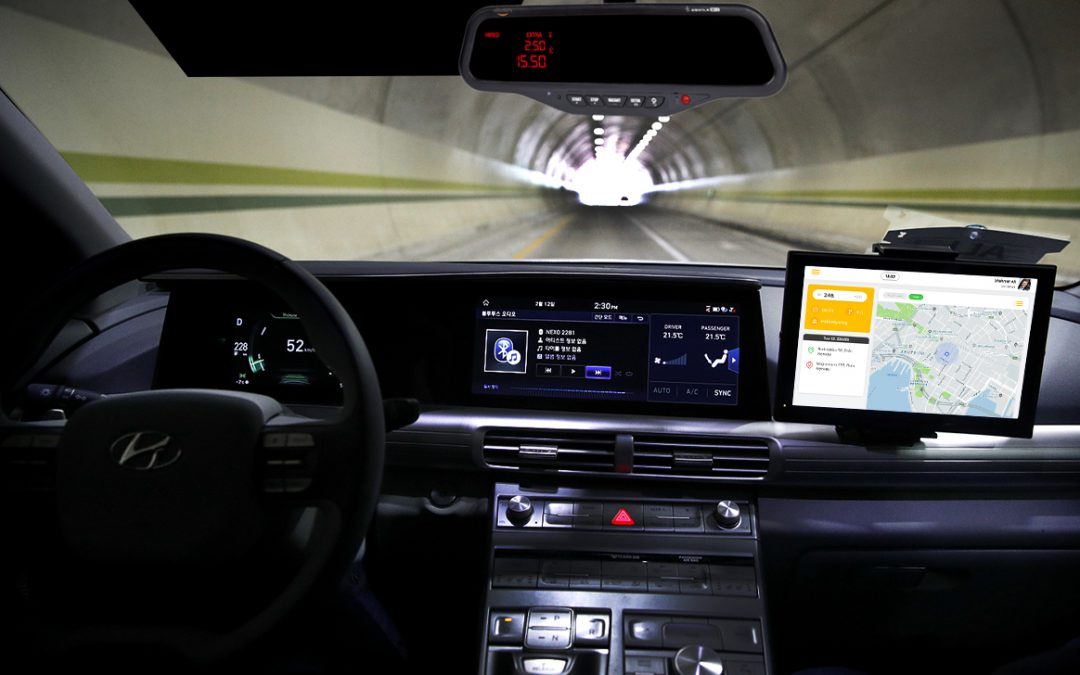A taximeter is an electrical device used to calculate the fare of a taxi ride based on the distance traveled and the time elapsed. As a taxi owner, installing an advanced taximeter is not just an upgrade—it is a must.
With the evolution of technology, taxi dispatch solutions are getting more advanced. It ultimately results in making it tough for small and large fleet owners to keep up. With the implementation of Norway’s new taximeter law, ensuring compliance has become more crucial than ever.
Every taxi driver now required to have a MID-approved (Measuring Instruments Directive) taximeter, which will be checked every year by the Norwegian Metrology Service. Without it, drivers won’t be allowed to operate. Understanding how do taxi meters work is very important for those operating taxi fleets especially in Norway, as every cab driver who wants to stay on the road must have a Measuring Instruments Directive (MID) approved taxi meter.
- What is a Taximeter?
- How Does a Taxi Meter Work?
- Understanding the Technical Functionality of Taximeters
- Advanced Technical Capabilities
- Advantages Of Taximeter
- Features of Modern Taximeters
- Do Taxi Meters Start at 0?
- Key Components of a Taxi Meter
- How to Install a Taxi Meter
- Boost Your Taxi Fleet's Efficiency with Cabsoluit's Advanced Solutions
- Upgrade Your Taxi with MID-Approved Taximeter!
- Conclusion
What is a Taximeter?
A taximeter is a device installed in taxis to calculate the fare based on the distance traveled and waiting time of a taxi ride Taximeter Is an essential tool that ensures transparency and fairness for both the passenger and the driver. For taxi businesses looking to further optimize their operations, leveraging advanced fleet management strategies and installing a taxi meter can significantly enhance efficiency and reduce operational costs.
‘’You Need A Device That Tells You The Truth & Thrive Your Business, No Matter How Expensive It Is’’
How Does a Taxi Meter Work?
At the end of the trip, the driver presses the STOP button to enter end mode. The tracking device would send data to the server, including start time, end time, total time, waiting time, distance, and fare. But here this is not all. At the backend there is a long process. So, we have answered for you the technical side as well; don’t worry.
Understanding the Technical Functionality of Taximeters
At the end of the trip, the driver presses the STOP button to enter end mode. The tracking device would send data to the server, including start time, end time, total time, waiting time, distance, and fare. But here this is not all. At the backend there is a long process. So, we have answered for you the technical side as well; don’t worry.
Core Functionality
The core job of a taximeter is to calculate fares based on two variables:
1. Distance traveled
2. Time elapsed, including waiting or idle time
The latest versions use sensors connected to the vehicle’s transmission and integrate with GPS to monitor movement. It generates electronic pulses every time a specific unit of distance or time passes (e.g., every meter or every second). These pulses are accumulated and matched against the configured fare rules.
For example:
- For every 200 meters of travel, a certain fare unit is added (e.g., $0.50)
- If the vehicle is stationary or in traffic, the meter switches to time-based charging (e.g., $0.50 per 60 seconds)
The real-time logic of the meter switches between distance and time — whichever generates pulses more quickly — ensuring that drivers are fairly compensated, whether they’re moving or waiting.
Fare Calculation Logic
Here’s how the taximeter calculates the fare:
● Initial Fare: A base charge (e.g., $3.00) is applied as soon as the ride begins.
● Distance-Based Additions: The meter adds an amount every time the car travels a set distance.
● Time-Based Additions: During stops or heavy traffic, it adds fare based on time intervals.
● Combined Mode: The system intelligently merges the two modes (distance and time), depending on traffic behavior.
● Tariff Codes: Multiple tariffs (e.g., day/night rates, weekend surcharges) are pre-programmed and activated automatically by time or manually by driver/admin.
Related Article: How Does Taxi Dispatch Software Benefit Taxi Owners?
Advanced Technical Capabilities
● Built-in GPS: For accurate location tracking and distance measurement.
● Programmable Tariffs: Configurable via calendar-based systems for automated rate switching.
● Driver Interface: Easy-to-use buttons for trip start, end, fare code selection.
● Integration Support: Compatible with backend fleet systems and digital dispatch software
● Printer Support: Option to connect with CR-01 printers for physical receipts.
● Real-time Sync: Can be paired with ride-hailing platforms for fare tracking, app receipts, and audits
Advantages Of Taximeter
Fair Pricing & Transparency
- Taxi meters aid in avoiding any misunderstanding about the fare amount by showing it clearly, thus facilitating objective calculation.
- Installing a taximeter in the cab helps in abiding by local regulations and keeping consistent rates in the taxi business. .
- Taxi meters enable passengers to trust that any charges they incur are honest.
- Taxi meters help ensure the computation of the correct fare based on the time taken and distance traveled for a taxi ride.
Safety & Compliance
- MID-approved taximeter is a cost-effective device & GPS-based app to create easiness for Drivers and Passengers to reach their goal.
- A taxi meter is a tool that makes your journey fraud control & it has been mandatory in Norway for every taxi. Norwegian Ministry of Transport and Communications is managing the taxi market on the national level.
- Taxi meters use objective measures to protect both drivers and passengers. If you pay attention to the meter and know your rights, there’s no reason to worry.
Operational Efficiency
- Installing a taxi meter decreases the driver’s unethical behavior; the taxi meter function in GPS tracking can diminish cab drivers’ exploitation behaviors; management can obtain real-time fare data online.
- One of the advantages of taxi meter installation is a reliable device that provides a precise portion of what the charge should be.
- Having a taximeter, you can easily acquire the data of distance, consumed fuel, and total fare or income of your rides.
- The GPS tracking in taximeters can improve your routes, and you can reach your customers on time, which results in good service.
Related Article: Top 10 Best Taxi Dispatch Softwares In 2025
Features of Modern Taximeters
Modern taximeters come with various features to enhance functionality:
-
Digital Displays:
Clear, easy-to-read displays for both drivers and passengers.
-
Printers:
Capability to print receipts for passengers.
-
GPS Integration:
Accurate measurement of distance and navigation assistance.
-
Tamper-Proof:
Security features to prevent tampering and ensure accurate fare calculation.
-
Multiple Fare Structures:
Ability to set different fare structures for different times of the day or types of trips (e.g., airport trips, night rates).
Do Taxi Meters Start at 0?

Key Components of a Taxi Meter
Understanding the key components of a taxi meter helps in answering the question, how do taxi meters work. These components ensure the accurate calculation of fares and seamless operation of the device. Here are the primary parts:
Display Unit:
The display unit is the most visible part of the taxi meter. It shows the fare, distance traveled, and waiting time. This allows passengers and drivers to see the current fare immediately, ensuring transparency.
Control Buttons:
Control buttons are used by the driver to operate the meter. They can start and stop the fare calculation, switch between different modes (such as waiting time and travel time), and reset the meter for the next ride.
GPS System:
Many modern taxi meters come equipped with a GPS system. This helps in accurately tracking the distance traveled and the route taken. The GPS data is crucial for precise calculation of fare and distance traveled, especially in cities with complex road networks.
Connection to Vehicle’s Systems:
The taxi meter is often connected to the vehicle’s systems, such as the odometer. This connection ensures that the meter can accurately measure the distance traveled by the taxi. The integration of the vehicle’s systems is essential for reliable fare computation.
Printer (for Receipts):
Some taxi meters include a built-in printer. This allows the driver to provide passengers with printed receipts that detail the fare, distance traveled, and elapsed time of a taxi ride. Receipts are useful for passengers for expense claims and record-keeping.
These components work together to ensure that taxi meters can accurately and transparently calculate fares based on distance traveled and the time elapsed. Understanding these key parts helps in comprehending how taxi meters work and their importance in the taxi industry.
How to Install a Taxi Meter
Instructions for Installation
Installing a taximeter involves several steps:
1. Selection of Meter:
Choose a meter that complies with local regulations and is compatible with your vehicle.
2. Wiring:
Properly wire the meter to the taxi’s electrical system. This often involves connecting it to the vehicle’s power supply and integrating it with the odometer or GPS system.
3. Calibration:
Calibrate the meter to ensure accurate fare calculation. This involves setting the correct fare structure and testing the meter for accuracy.
4. Mounting:
Securely mount the meter in a visible and accessible location within the taxi.
Instructions and Manual
Each taximeter comes with a detailed manual that provides specific instructions for installation, operation, and maintenance. It’s crucial to follow these guidelines to ensure the taximeter operates correctly and complies with local regulations.
Taxi Meter Fitting
1. Professional Fitting Services
Professional taximeter fitting services are readily available for individuals who aren’t adept at DIY approaches. In practical situations, how taxi meters operate becomes pertinent. These services ensure that the meter is installed correctly and calibrated according to local laws. Professional fitting often comes with a guarantee of accuracy and compliance.
2. Installation Tips
For those who prefer to install the meter themselves, here are some tips:
- Read the Manual: Thoroughly read the instructions and guide provided with the taximeter.
- Use Proper Tools: Ensure you have the necessary tools for the installation.
- Follow Wiring Diagrams: Accurately follow the wiring diagrams to avoid electrical issues.
- Test Thoroughly: After installation, test the meter in various conditions to ensure accuracy.
Boost Your Taxi Fleet’s Efficiency with Cabsoluit’s Advanced Solutions
As a business, we have been involved in the taxi industry for over 20 years. We know that having the best equipment on the road is crucial. Providing the best service to customers is the most important thing a fleet can do. Understanding how taxi meters work helps in making informed upgrade decisions. It also ensures compliance with regulations.
Our industry-leading products include MID-approved taximeters for ours taxi dispatch software. We have everything your fleet needs to succeed in the modern age. Automate your taxi business with fully equipped and advanced features.
These features are essential for business growth. With Cabsoluit, you can enjoy features like:
Booking & Ride Management
- Booking App (iOS, Android)
- Driver App (iOS, Android, Android Tab)
- Booking Management
- Booking Terminal
Fleet Tracking & Dispatch
- Vehicle Tracking – GIS
- Dispatch System
Fare & Payment Management
- Fare Calculator
- Fare Management
Business & Admin Tools
- Admin Portal
- Owners Portal
- Ticket Management
- Reports
- Analytics (Power BI)
System Integrations
- External Integrations
Upgrade Your Taxi with MID-Approved Taximeter!
- Cost-Effective, Reliable and Accurate.
- Precision in every ride! Our accurate taxi fare calculator ensures transparent pricing, enhanced safety, and efficient route planning with GPS-tracking mirror taximeters.
- Join hundreds of professional drivers worldwide in the Alberen family for cost reduction and optimal service. Start driving today with seamless taxi meter installation!
So, if you are truly interested to make secure & raise your business according to Norwegian law. Our proficient team is facilitating worldwide customers. Contact us now for a free demo and bring a change to your cab business and get an Alberen Taximeter.
Conclusion
Understanding how taxi meters work is essential for both drivers and passengers. Taxi meters accurately measure the distance traveled and waiting time to calculate the fare, ensuring transparency and fairness. With features like GPS integration and compliance with local regulations, taxi meters help avoid misunderstandings between the drivers and passengers about fare amounts and enhance trust. For taxi fleet owners, upgrading to advanced taximeters can improve service efficiency and customer satisfaction. Knowing how taxi meters work allows drivers to provide reliable and honest service, ultimately benefiting the entire taxi industry. By staying informed, you can ensure a smooth and fair experience for all.



